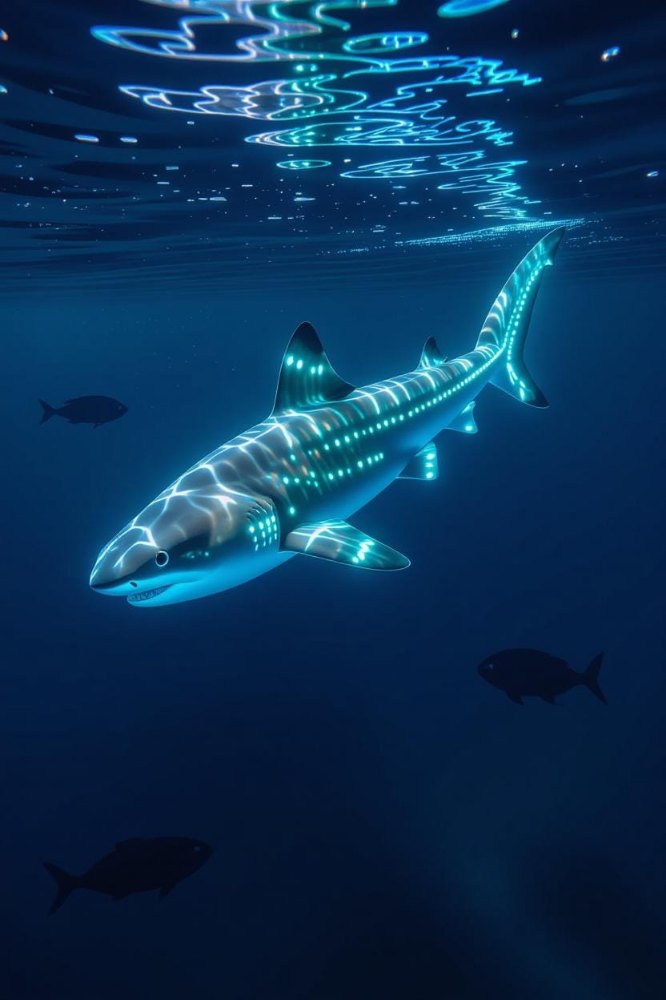Sharks That Glow in the Dark: Nature’s Deep-Sea Light Show
The ocean at night is not always pitch black. In its deepest corners, where sunlight never reaches, a strange blue-green glow flickers like a living aurora.
It comes not from lanternfish or jellyfish but from a surprising predator: sharks. Far from the classic image of a shadowy hunter, several shark species literally glow in the dark.
This phenomenon, known as biofluorescence, is one of the ocean’s least known but most fascinating natural spectacles. Most people imagine sharks as gray torpedoes with teeth, gliding silently through sunlit shallows.
Yet the deep sea hosts species adapted to extreme darkness, pressure, and scarcity of food. Among them are biofluorescent sharks such as the chain catshark, the swell shark, and the velvet belly lanternshark.
These creatures carry special pigments in their skin that absorb the faint blue light filtering from above and re-emit it in greenish patterns. Unlike bioluminescence, which involves producing light through chemical reactions, biofluorescence is a form of light transformation.
The sharks do not create new light; they modify existing light to make themselves glow. In 2014, marine biologists diving off the coast of California noticed something extraordinary while shining blue lights on the seafloor.
The chain catshark, normally patterned with dark brown rings, lit up with electric green markings along its body.
Cameras equipped with filters that mimic a shark’s vision revealed even more intricate patterns invisible to human eyes under normal conditions.
This discovery changed how scientists view shark communication and camouflage. For the first time, it became clear that many sharks might inhabit a world glowing with secret signals we cannot see.
Researchers think biofluorescence in sharks serves several purposes. One is camouflage. In the deep ocean, predators and prey alike must find ways to blend with the dim blue light from above.
By absorbing and re-emitting this light in green, sharks may reduce their silhouettes and appear less threatening to potential prey. Another reason may be communication.
The glowing patterns on some sharks’ bodies line up with key features like fins or gill slits. They could act as identification badges, allowing sharks of the same species to recognize each other or signal readiness to mate.
There is even speculation that biofluorescence could confuse or dazzle predators, much like a flashing decoy. What makes these glowing sharks even more remarkable is how their eyes are tuned.
Recent studies show that biofluorescent shark species have retinas particularly sensitive to the greenish wavelengths they emit. In effect, they have built-in night-vision goggles tailored to their own glow.
This co-evolution of light and vision hints at a complex underwater communication network still hidden from science.
If humans could see the world as these sharks do, the deep ocean might look less like a black void and more like a neon-lit cityscape. The velvet belly lanternshark takes glowing to an extreme.
It sports light-producing organs called photophores on its belly that make it bioluminescent as well as biofluorescent. These photophores allow it to match the faint sunlight above, a trick known as counter-illumination.
By glowing on its underside, the shark erases its shadow and becomes almost invisible to predators looking up from below. Combined with biofluorescent markings on its sides and fins, the lanternshark effectively cloaks itself in a shifting veil of light.
Understanding these adaptations could help humans in surprising ways. Engineers studying biofluorescent sharks hope to develop new underwater imaging systems, stealth coatings, and communication methods inspired by their light tricks.
Medical researchers are also interested because the proteins and pigments behind biofluorescence are similar to those used in biomedical imaging.
Just as green fluorescent protein from jellyfish revolutionized cell biology, shark pigments may open new windows into the microscopic world. Despite the excitement, much about glowing sharks remains mysterious.
Scientists still do not know exactly how many species possess biofluorescence, how their patterns change over time, or what specific messages they send.
Studying them is hard because they live in remote, lightless habitats where dives are expensive and risky. Specialized cameras and lights are required to capture their secret signals.
Yet each new expedition uncovers more evidence that the deep sea is alive with hidden colors. One striking experiment involved tagging swell sharks with tiny cameras and blue-light emitters to follow their movements at night.
The footage revealed shimmering outlines and pulsing marks as the sharks glided past corals and sponges, like ghosts carrying glowing tattoos. Other deep-sea creatures responded to these lights in unpredictable ways, suggesting a whole ecosystem of visual cues invisible to us.
In this sense, biofluorescence is not just a quirky trait but a major part of how life interacts in the ocean’s twilight zone. Public awareness of biofluorescent sharks is growing slowly.
Documentary filmmakers and photographers now use special filters to show audiences the hidden colors of the deep. When people see a shark glowing green like a living light stick, their fear often turns to fascination.
It’s a reminder that these animals are not just hunters but marvels of evolution, perfectly adapted to an alien world on our own planet. Next time you picture a shark, think beyond the gray silhouette.
Imagine a predator painted in invisible ink, moving through darkness in a glowing whisper, communicating in colors we cannot see.
The ocean still hides countless secrets, but glowing sharks give us a thrilling glimpse of its hidden light show. They reveal that even in the planet’s darkest places, life finds ways to shine.
















































